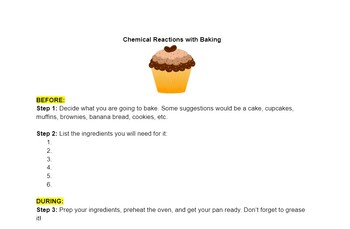Science Baking Lab Particle Motion work sheet
Korthinthemiddle
1 Follower
Grade Levels
4th - 7th
Subjects
Resource Type
Standards
NGSSMS-PS1-4
NGSSMS-PS1-5
NGSSMS-PS1-6
Formats Included
- Google Docs™
Korthinthemiddle
1 Follower

Made for Google Drive™
This resource can be used by students on Google Drive or Google Classroom. To access this resource, you’ll need to allow TPT to add it to your Google Drive. See our FAQ and Privacy Policy for more information.
Description
This lab emphasizes science standards while also having fun! This is a lab perfect for students who are doing online learning or are homeschooled because they will likely have something they can bake at home.
Total Pages
Answer Key
N/A
Teaching Duration
N/A
Report this resource to TPT
Reported resources will be reviewed by our team. Report this resource to let us know if this resource violates TPT’s content guidelines.
Standards
to see state-specific standards (only available in the US).
NGSSMS-PS1-4
Develop a model that predicts and describes changes in particle motion, temperature, and state of a pure substance when thermal energy is added or removed. Emphasis is on qualitative molecular-level models of solids, liquids, and gases to show that adding or removing thermal energy increases or decreases kinetic energy of the particles until a change of state occurs. Examples of models could include drawings and diagrams. Examples of particles could include molecules or inert atoms. Examples of pure substances could include water, carbon dioxide, and helium.
NGSSMS-PS1-5
Develop and use a model to describe how the total number of atoms does not change in a chemical reaction and thus mass is conserved. Emphasis is on law of conservation of matter and on physical models or drawings, including digital forms, that represent atoms. Assessment does not include the use of atomic masses, balancing symbolic equations, or intermolecular forces.
NGSSMS-PS1-6
Undertake a design project to construct, test, and modify a device that either releases or absorbs thermal energy by chemical processes. Emphasis is on the design, controlling the transfer of energy to the environment, and modification of a device using factors such as type and concentration of a substance. Examples of designs could involve chemical reactions such as dissolving ammonium chloride or calcium chloride. Assessment is limited to the criteria of amount, time, and temperature of substance in testing the device.


